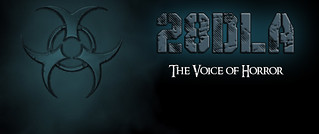Director: Panos Cosmatos.
Writers: Panos Cosmatos and Aaron Stewart-Ahn.
Cast: Nicolas Cage, Andrea Riseborough, Linus Roache, Ned Dennehy, Bill Duke and Olwen Fouéré.
Eight years have passed since Panos Cosmatos brought Beyond the Black Rainbow to screens. This feature was a psychedelic mind trip, set in the '80s and in an illicit laboratory; a very unforgettable film. Cosmatos' latest, Mandy, is similarly hallucinogenic. Lens flares streak the screen and dialogue often sounds like an auditory hallucination. What can only be called a psychedelic revenge thriller, Mandy is a film that is also very memorable as Red (Nicholas Cage) looks for revenge, after the death of his wife (Andrea Riseborough). Other horror films influence the screen, even though Cosmatos was forbidden to watch them as a child. The lighting is equally unsettling. It is amazing that so many colours can fit on the screen, at the same time. As well, Cosmatos explores spirituality within the film; his conclusion is that religion is mostly bad as seen by those who wear the crosses (all villains). Finally, Mandy is a creative wonder, that will stimulate most minds.
Cosmatos has really created his own genre, here. But, the film's genre can best be described as a psychedelic revenge thriller. Straight out from the intro' credits, the colours don't match, while names consistently stand-out. Later in the film, characters are shown with auras and strange hues. Almost everyone is on a bad batch of LSD, with the results a bit cosmic and other-wordly. In the midst of all the strange colours and sounds, Red is struggling to free himself from a group of "Jesus freaks." But, his wife bears the brunt of the brutality, leading to Red's eventual desire for justice. Almost every scene, within Mandy, has been amplified somehow, whether through lighting or the audio soundtrack.
The story does come across as a straight up revenge thriller. Red and Mandy enjoy their times near Crystal Lake. They tell stories or relive memories. However, the cult leader Jeremiah Sand (Linus Roache) also has his eyes on Mandy. Their paths cross, when she is chased down by a motorcycle gang from hell. Once the violent wheels are put into motion, Mandy's time is running out - unless Red can find a way to save her. Not much later, Red is hunting down coke using porn addicts. One blackened character even has a blade for a penis. All of these violent encounters are leading to a final showdown between Red and Sand.
Long time horror fans may see a few nods to previous films, especially of the horror persuasion. As mentioned above, Crystal Lake gets a nod - from the Friday the 13th series of films. Though, there is no masked Jason here. Later, the bikers turn up, suited like characters from Clive Barker's Hellraiser (1987). Their movements look very similar to these other denizens of Hell. Other reviews have mentioned connections with Silence of the Lambs, especially through some of the scenes with Mandy. These connections are more difficult to make. Though chainsaws appear, it is also difficult to connect this film with The Texas Chainsaw Massacre series. There are no cannibals here. Though, the bikers in Psychomania (1973) do ride, again.
Cosmatos' use of lighting continues to create a visual marvel. The visuals, in Mandy, are consistently strong. In one scene, several cultists wait outside of Mandy and Red's cabin. The rear of the van shows reds and blues, while the front shows more whites. It is amazing to see so many vibrant colours onscreen, in a single shot. When characters share scenes, they are often lit with different shades and hues, possibly emphasizing the different emotional contexts. In the climax, there are a lot of appropriate reds and blacks as Red descends into Hell. Cosmatos' visual sphere is particularly striking and the colours run the gamut.
Finally, Cosmatos mentions that the film is an exploration of spirituality. He tends to cast religion in a negative light, though. The characters that mention God are all villains. Cosmatos has even mentioned, in an interview, that: "I can’t get past this idea, this sort of suspicion of people that want to have all the answers, especially spiritual (Screen Anarchy)." Of course, no one has all of the answers, unless one believes in a higher power. And, much of the religious icons in the film, such as a triangular church, are burned to the ground - a fiery effigy. The hero proclaims: "I am your God," with some hubris. But, Cosmatos has few answers, in relation to spirituality, as well.
Mandy has recently seen a theatrical run and a release on Digital, in the United States. In Canada, Elevation Pictures has brought the film to several screens. And, the theatrical experience is the best way to see Cosmatos' visual treat - Mandy. There was no such opportunity to see Beyond the Black Rainbow, in a similar fashion. This is also a film that should not be missed, with the filmmakers pushing visual and storytelling boundaries. The religous Dogma is a bit on the negative side. Still, good is often difficult to beat in the long run. And, this psychedelic revenge thriller (the first of its kind) will leave you thinking about the film, long after the curtains are closed.
Overall: 8.5 out of 10.
A review of Beyond the Black Rainbow, on 28DLA: A Beyond the Black Rainbow Review (Blu-ray)
An Interview with Panos Cosmatos at Screen Anarchy: Panos Cosmatos Interviewed at Screen Anarchy
Follow 28DLA on Twitter: 28DLA on Twitter!
Subscribe to 28 Days Later: An Analysis 28 Days Later Analysis Email Subscription


 Saturday, September 29, 2018
Saturday, September 29, 2018
 Michael Allen
Michael Allen




 Posted in:
Posted in: 


0 comments:
Post a Comment